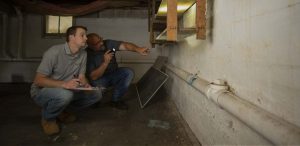Trouble In The Queen City: The Rising Concern Of Lead Exposure
Lead is a soft, heavy metal previously used in paint to stretch the life of the color in buildings. Lead-based paint was used extensively as a surface coating until 1978, when the federal government banned its consumer use.
Lead-based paint and lead-contaminated dust remain a concern in older homes because of the risk of lead poisoning. Health problems arise when toxic lead paint degrades (chips, cracks, or flakes) into paint chips and dust particles.
Lead poisoning is dangerous, especially in developing children and pregnant women.
A City at Risk
 Blood lead levels in children continue to decline in the United States, but not in Buffalo, New York, an aging, post-industrial city.
Blood lead levels in children continue to decline in the United States, but not in Buffalo, New York, an aging, post-industrial city.
Children from low socio-economic status are impacted the most, despite government intervention, policies and practices to prevent lead exposure, and watchful governing agencies. Place-based or residential segregation likely exists in some parts of the city, perpetuating the cycle of lead exposure.
The impact of residential segregation: It’s obvious. Impoverished families living in deteriorated housing stock are at risk every day because they do not have the means to live elsewhere and often do not have access to quality healthcare for proper testing.
According to a 2018 study, Buffalo suffers from some of the highest rates of childhood lead exposure in the nation, citing “poor housing conditions in old homes with lead paint.” Pre-existing patterns of residential segregation significantly impact children of color who live in deteriorated houses with poor indoor air quality.
Children who live in communities of color are 12 times more likely than children who live in predominantly white neighborhoods to be diagnosed with an elevated blood lead level.
Paradoxically, environmental laws govern the entire state regardless of socioeconomic status disparities. But discrepancies between suburban neighborhoods and communities in Buffalo are a reality. One would think that poor housing conditions should not exist at the level they do in Buffalo, but the data speaks for itself.
Two questions arise in this exploration of the current environmental conditions in Buffalo:
The first question is: Is it important to focus on community outreach to educate families about blood lead testing for children?
 Local governments should launch awareness campaigns to educate parents about blood lead testing for children. The federal government requires children two and under to undergo blood tests for lead poisoning; however, children up to six years old are affected.
Local governments should launch awareness campaigns to educate parents about blood lead testing for children. The federal government requires children two and under to undergo blood tests for lead poisoning; however, children up to six years old are affected.
The age gap is a critical four-year period for children exposed to lead.
Anthony DeMiglio has worked in the Environmental Sciences industry for over twenty years. His company, AMD Environmental Consultants, performs lead inspections and testing all over Western New York. DeMiglio has exceptional knowledge of Buffalo’s current housing stock conditions and lead rates.
When asked about educating parents, DeMiglio says, “Education reinforces the need for basic hygiene and diet. The bare minimum includes washing floors and other horizontal surfaces and offering children a well-balanced diet. A poor diet, one that is high in fat and deficient in nutrients, causes a child’s body to absorb lead which then stores the mineral in the bones or tissues.”
Parents must understand how risky it is to live in lead-contaminated houses and how they can protect their children.
The second question is: Should housing structures in high-risk areas be inspected more often for lead-based paint exposure, particularly in rental properties?
Subsidized housing standards are currently in place to determine Housing Quality Standards (HSQ). But, HSQ is not required for all Buffalo rental properties, leaving many children vulnerable to contaminated homes.
In most cases, homeowners are cited for poor paint quality OUTSIDE the home, but not INSIDE.
According to a comprehensive publication released in 2018, Policies to Reduce Lead Exposure: Lessons from Buffalo and Rochester, New York State offers a way to prioritize proactive inspections by need.
The State Department of Health authorizes counties to declare high-risk neighborhoods based on EBLL ( Elevated Blood Lead Levels ) data; the county’s Health Department then makes its way through those neighborhoods, doing inspections and lead testing, and issuing orders for repairs where needed.
Marginalized and Left With Few Options
 The issue of high lead poisoning in Buffalo is complicated because of several factors.
The issue of high lead poisoning in Buffalo is complicated because of several factors.
Poverty Rate
The poverty rate is among the highest in the nation. Regionally the poverty rate is 15%, but Buffalo stands at 30%, impacting many people of color. Poverty and lead poisoning should not be synonymous, but it is a reality.
Minority populations
Most Elevated Blood Lead Levels (EBLL) cases in children (in WNY) concentrate in Buffalo. The affected children live in single or double-family rental properties owned by at least 1200 landlords. Despite government efforts to reduce lead exposure, low socioeconomic status is a common denominator among children with EBLL in the city.
Housing quality
Buffalo’s housing stock is old compared to the rest of the country. Ninety-three percent of the homes in Buffalo were built before 1980 and painted with lead-based paint. Oxidized paint increases the potential for lead exposure.
Caution: Children at Play
 For numerous reasons, lead poisoning cases, particularly paint-based exposures, are the highest in the summer.
For numerous reasons, lead poisoning cases, particularly paint-based exposures, are the highest in the summer.
One reason the state sees an uptick in cases in the summer is that people open windows more often during the warmer months. Breathing in lead dust increases when lead-based paint surfaces like window sills or doors open and close frequently.
Fetuses are also at risk of lead poisoning as well. Pregnant women who breathe in lead dust transmit lead to their unborn babies.
Another reason for the uptick in cases in the summer is that children play near contaminated soil. Children become exposed to contaminated soil when lead-paint chips off into the soil. There’s a risk of tracking lead into a home, further exposing other family members.
There are more problems associated with lead-contaminated soil than just exposure. People who grow culinary herbs, vegetables, or fruit in gardens near their homes ingest lead unknowingly.
The consequences of eating lead are life-altering, especially for young children.
What Are The Signs Of Lead Poisoning In Children?
Lead poisoning symptoms present in children the same way viruses do, often leading to misdiagnosis.
When blood levels are high, signs of lead poisoning can include the following:
- Headache
- Stomachache
- Nausea
- Irritability
- Fatigue
The health effects are long-lasting and include serious damage to body systems.
Lead damage can cause:
- Lower intellectual functioning (lower IQ)
- Brain damage
- Liver and kidney damage
- Learning disabilities
Early Testing Lowers Risk of High Exposure
 New York State Public Health Law requires all children two years and under to receive blood tests, mainly because young children are the most vulnerable to lead exposure.
New York State Public Health Law requires all children two years and under to receive blood tests, mainly because young children are the most vulnerable to lead exposure.
The reports of lead poisoning in Buffalo are a bit of a puzzle.
On the one hand, Erie County has high blood lead-level testing rates, which should lead to early intervention. On the other hand, high testing rates could be because of the high number of exposures.
One thing is clear; early testing may prevent prolonged exposure.
Regulate and Educate
Despite deteriorating housing stock and other challenges facing minority families, federal government policies that reduce lead exposure are somewhat effective.
As a result of multiple federal laws and regulations, including the 1973 phase-out of lead in automobile gasoline, the 1978 federal regulation banning lead paint for residential and consumer use, and the 1995 ban on lead in solder in food cans, the median concentration of lead in the blood of children aged 1 to 5 years dropped from 15 micrograms per deciliter in 1976–1980 to 0.7 micrograms per deciliter in 2013–2014, a decrease of 95%.
In addition to long-standing regulations, the federal government has taken further action to ensure the health and safety of children.
The United States government enacted the Federal Action Plan to Reduce Childhood Lead Exposures and Associated Health Impacts (Action Plan) in 2018.
The Action Plan will help federal agencies work strategically and collaboratively to reduce exposure to lead and improve children’s health.
Regulatory policies are only possible with all stakeholders invested in preventing exposure to lead. Stakeholders include state officials, local governing agencies, tribes, property owners, and parents with young children, especially those in vulnerable locations.
The Action Plan outlines four child-centered goals:
GOAL 1: Reduce Children’s Exposure to Lead Sources
GOAL 2: Identify Lead-Exposed Children and Improve Their Health Outcomes
GOAL 3: Communicate More Effectively With Stakeholders
GOAL 4: Support and Conduct Critical Research to Inform Efforts to Reduce Lead Exposures, and Related Health Risks
The agenda pushed forward by the federal government is a multidimensional approach that requires experienced environmental consultants who understand the laws and science behind lead poisoning prevention.
AMD Environmental Consultants, a Western New York-based company, fully grasps the lead problem in Buffalo, New York.
AMD Environmental’s approach to the lead issue is focused on awareness of regulatory changes and advising clients about compliance and potential health and legal concerns.
 Skilled environmental technicians use state-of-the-art X-ray fluorescence (XRF), a HUD-specified method, for identifying lead-based paint in housing. XRF is fast and non-destructive and reads through multiple layers of paint (up to 3/8 of an inch) that may be built up on a surface.
Skilled environmental technicians use state-of-the-art X-ray fluorescence (XRF), a HUD-specified method, for identifying lead-based paint in housing. XRF is fast and non-destructive and reads through multiple layers of paint (up to 3/8 of an inch) that may be built up on a surface.
AMD Environmental Consultants performs inspections on:
- Single and multi-family dwellings
- Apartment buildings
- Commercial properties
- Schools and daycare centers
- Medical offices
- Sites under construction
AMD Environmental can fulfill all lead paint test and inspection needs.
The team of professionals helps property owners who:
- Aim to comply with federal, state, and city regulations governing lead-based paint
- Apply for homeowner’s insurance
- Seek mortgage approval
- Suspect lead exposure at your residence
- Need Lead-Based Paint Risk Assessments
A residential lead-based paint risk assessment will discover any lead-based paint hazards.
AMD Environmental’s lead paint risk assessment includes the following:
- A visual inspection of the dwelling
- An assessment of building history, age, management, and maintenance of the dwelling
- The number of children under the age of 6 and women of childbearing age who reside or frequent the dwelling
- A sampling of deteriorated paint, dust, and soil for testing in our lab
Buffalo needs people to be part of the solution in raising awareness about lead poisoning while holding property owners accountable for safe housing. If you think a child has been exposed to lead or is exhibiting unusual symptoms, contact a pediatrician immediately for a blood test.
If the source is unknown, contact AMD Environmental.
Works Cited
Magavern, S. (2018). Policies to Reduce Lead Exposure: Lessons from Buffalo and Rochester. International Journal of Environmental Research and Public Health, 15 (10). https://doi.org/10.3390/ijerph15102197\

